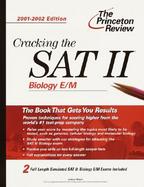The Princeton Review Cracking the SAT II: Biology
- List Price: $18.00
- Binding: Paperback
- Publisher: Princeton Review
- Publish date: 01/01/2005
Description:
The Princeton Review realizes that acing the SAT II: Biology E/M exam is very different from getting straight As in school. They don't try to teach students everything there is to know about biology--only what they'll need to score higher on the exam. There's a big difference. In Cracking the SAT II: Biology E/M, The Princeton Review will teach test takers how to think like the test makers and: * Score higher by reviewing key biology concepts * Earn more points by becoming familiar with the format of the test * Safeguard against test traps that can lower scores * Perfect skills by practicing review questions in each chapter *** This book includes 2 full-length simulated SAT II: Biology E/M exams. All of the sample test questions are just like the ones test takers will see on the actual exam, and every solution is fully explained. Contents Include: I Introduction Point 1: Approaching the Test Strategically Point 2: Teaching You the Biology You Need to Know to do Well on the Exam II The Exam Format, Question Types, and Strategies The Format Classification Questions Five-Choice Questions Laboratory Five-Choice Questions Strategy 1: Study the Right Stuff the Right Way Strategy 2: Practice the Right Stuff at the Right Time Strategy 3: Easy Stuff First Strategy 4: Take a Guess, but Guess Smart Strategy 5: Choosing the "Wrong" Answer--Least/Except/Not Questions Strategy 6: I, II, III--You're Out! Strategy 7: Avoid the Camouflage Trap Strategy 8: Avoiding the Temptation Trap--Predict an Answer Strategy Summary Special Tips for Laboratory Five-Choice Questions III Cracking Cellular and Molecular Biology Biologically Important Macromolecule #1: Protein Biologically Important Macromolecule #2: Carbohydrate Biologically Important Macromolecule #3: Lipid Biologically Important Macromolecule #4: Nucleic Acid Eukaryotic Cell Structure What Goes On in the Cytoplasm: Chemical Reactions and Enzymes Time to Talk about Cellular Respiration Glycolysis The Pyruvate Dehydrogenase Complex (PDC) The Krebs Cycle Electron Transport and Oxidative Phosphorylation What Happens if Oxygen is NOT Available? DNA Replicates Itself Chromosomes How chromosomes Govern Protein Synthesis: Transcription and Translation More About Translation How Translation Works, Part 1: tRNA How Translation Works, Part 2: The Ribosome How a Whole Cell Reproduces Itself: Mitosis IV Cracking Genetics Remember Why Chromosomes are Important The Formation of Gametes: Meiosis Let's Get Back to Genetics Phenotype and Genes Mating and Crossing Punnett Squares Sex and Sex-Linked Traits Pedigree Analysis V Cracking Evolution and Diversity The Origin of Life Evolution Getting Organized: Phylogeny Kingdom Monera Kingdom Protista Kingdom Plantae Kingdom Fungi Kingdom Animalia VI Cracking the Structure and Functions of Organisms Control of the Body, Part 1--The Nervous System Control of the Body, Part 2--The Endocrine System Transport Within the Body--The Circulatory System Blood Typing The Heart Ventilation and Gas Exchange Body Processing, Part 1--The Digestive System Body Processing, Part 2-- The Urinary system Support and Protection of the Body, Part 1--The Skeletal System Support and Protection of the Body, Part 2--The Muscular System Support and Protection of the Body, Part 3--The Skin Reproduction and Development, Part 1--The Male System Reproduction and Development, Part 2--The Female System Reproduction and Development, Part 3--Fertilization, Embryology, and Fetal Development The Structures and Functions of Plants Behavior, Learning, and Coexistence The Structures and Functions of Microorganisms VII Cracking Ecology What is a Population? What is a Community? More about the Community--Who's Who Let's Talk about Ecological Succession Getting Bigger--The Ecosystem What Goes Around Comes Around--Nutrient Cycles Getting Bigger Again--Biomes VIII The Princeton Review SAT II: Biology E/M Subject Tests
Expand description

Please Wait

